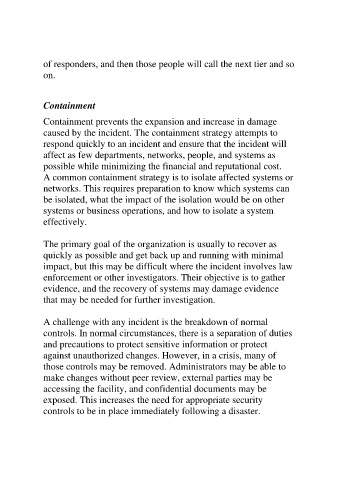Page 215 - CISSO_Prep_ Guide
P. 215
of responders, and then those people will call the next tier and so
on.
Containment
Containment prevents the expansion and increase in damage
caused by the incident. The containment strategy attempts to
respond quickly to an incident and ensure that the incident will
affect as few departments, networks, people, and systems as
possible while minimizing the financial and reputational cost.
A common containment strategy is to isolate affected systems or
networks. This requires preparation to know which systems can
be isolated, what the impact of the isolation would be on other
systems or business operations, and how to isolate a system
effectively.
The primary goal of the organization is usually to recover as
quickly as possible and get back up and running with minimal
impact, but this may be difficult where the incident involves law
enforcement or other investigators. Their objective is to gather
evidence, and the recovery of systems may damage evidence
that may be needed for further investigation.
A challenge with any incident is the breakdown of normal
controls. In normal circumstances, there is a separation of duties
and precautions to protect sensitive information or protect
against unauthorized changes. However, in a crisis, many of
those controls may be removed. Administrators may be able to
make changes without peer review, external parties may be
accessing the facility, and confidential documents may be
exposed. This increases the need for appropriate security
controls to be in place immediately following a disaster.

